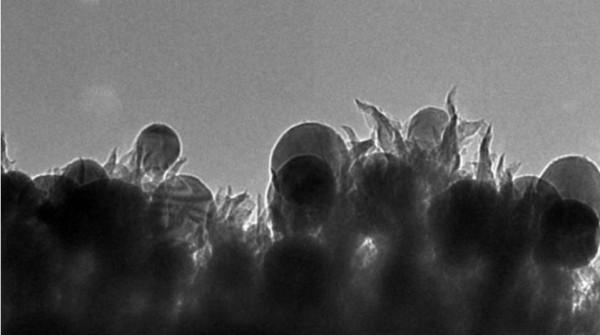CO2 Transformed into Ethanol Fuel by Astounding Laboratory Accident
| Arthur Dominic Villasanta | | Oct 21, 2016 05:51 AM EDT |
(Photo : ORNL) Copper nanoparticles (seen as spheres) embedded in carbon nanospikes were used to convert carbon dioxide into ethanol.
A magnificent accident has led to the discovery of a cheap and easy method that transforms the harmful greenhouse gas carbon dioxide (CO2) into the useful fuel called ethanol.
Scientists at the U.S. Department of Energy Oak Ridge National Laboratory (ORNL) in Tennessee accidentally discovered a method that converts CO2, a greenhouse gas and one of the leading causes of climate change, into ethanol, a liquid alcohol long used as a fuel for internal-combustion engines.
Like Us on Facebook
Experts said this newfound technical capability to recycle CO2 on a massive scale has the huge potential to help in the faster slowing down of global warming.
ORNL scientists said they were running a solution of carbon dioxide dissolved in water over a charged surface in the hopes of describing a reaction when they made their astonishing discovery.
They discovered that by putting copper and carbon together to create nanospikes on silicon; exposing the matter to CO2 dissolved in water and electrifying it, the solution was transformed into a highly-concentrated blend of ethanol. The solution of CO2 dissolved in water turned into ethanol with a yield of 63 percent.
"We discovered somewhat by accident that this material worked," said Dr. Adam Rondinone, study lead author.
"We were trying to study the first step of a proposed reaction when we realized that the catalyst was doing the entire reaction on its own. By using common materials, but arranging them with nanotechnology, we figured out how to limit the side reactions and end up with the one thing that we want."
The catalyst in question were nanoscopic spikes of carbon studded with copper nanoparticles that were electrified to reverse the combustion process.
"They are like 50 nanometer lightning rods that concentrate electrochemical reactivity at the tip of the spike," said Dr. Rondinone.
Unlike other CO2-to-fuel converting processes, this method uses more common materials such as carbon and copper. Also, the final product is ethanol, which is a widely-used fuel around the world.
Research into this new process is still in the early stages, however. Scientists are continuing to study the process to make it even more efficient and to learn more about how it and how it can be mass produced.
Tagscarbon dioxide, CO2, Ethanol, Oak Ridge National Laboratory, nanoscopic spikes of carbon, copper nanoparticles
©2015 Chinatopix All rights reserved. Do not reproduce without permission
EDITOR'S PICKS
-

Did the Trump administration just announce plans for a trade war with ‘hostile’ China and Russia?
-

US Senate passes Taiwan travel bill slammed by China
-

As Yan Sihong’s family grieves, here are other Chinese students who went missing abroad. Some have never been found
-

Beijing blasts Western critics who ‘smear China’ with the term sharp power
-

China Envoy Seeks to Defuse Tensions With U.S. as a Trade War Brews
-

Singapore's Deputy PM Provides Bitcoin Vote of Confidence Amid China's Blanket Bans
-

China warns investors over risks in overseas virtual currency trading
-

Chinese government most trustworthy: survey
-

Kashima Antlers On Course For Back-To-Back Titles
MOST POPULAR
LATEST NEWS
Zhou Yongkang: China's Former Security Chief Sentenced to Life in Prison

China's former Chief of the Ministry of Public Security, Zhou Yongkang, has been given a life sentence after he was found guilty of abusing his office, bribery and deliberately ... Full Article
TRENDING STORY

China Pork Prices Expected to Stabilize As The Supplies Recover

Elephone P9000 Smartphone is now on Sale on Amazon India

There's a Big Chance Cliffhangers Won't Still Be Resolved When Grey's Anatomy Season 13 Returns

Supreme Court Ruled on Samsung vs Apple Dispute for Patent Infringement

Microsoft Surface Pro 5 Rumors and Release Date: What is the Latest?














